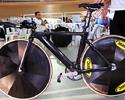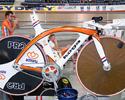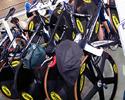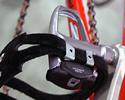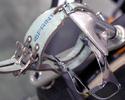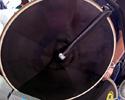
Recently on Cyclingnews.com |
Tech from the Sydney Track World Cup, November 30, 2006The Olympic testing groundCyclingnews' Ben Abrahams discovers some of the new (and not-so-new) equipment on show at Sydney's Dunc Gray Velodrome. The UCI Track World Cup is undoubtedly a big event, but for most countries with serious track programs, what really matters are medals at the world championships and most importantly, the Olympic Games. As the countdown to Beijing 2008 begins, riders and mechanics often use the world cup as a testing ground to squeeze every last thousandth from themselves and their equipment. First stop is the Great Britain team's pit area, awash with stealthy-looking all black machines, designed and built by the Advanced Composites Group (ACG) in Derby, UK - the same company which makes sections of the McLaren Mercedes Forumla One car. Mechanics and riders refer to these bikes as 'UKSI' after the UK Sports Institute who provide funding for the Great Britain Olympic team. The frames are designed using a method called finite element analysis; a computer simulation breaks the bike down into tens of thousands of individual elements so that stresses and deformations can be predicted accurately. The designers can then distribute material throughout the frame corresponding to these variations, thus optimising the bike's weight and strength. Factoring in all research and development costs, each frame is estimated to be worth a massive £26,000. While some trackies still prefer the reassurance of steel bars, carbon is becoming increasingly common up front. This may be due to the development of higher strength carbon technology or riders' willingness to sacrifice some of steel's strength for increased aerodynamics. ACG also manufacture an integrated carbon fibre bar and stem combination being tested by up-and-coming sprinter Ross Edgar. The Great Britain team wheels are a mixture of ACG's own creation, again sporting a minimal all-black paint job, and the occasional Mavic Comete disc. However, a GB mechanic told Cyclingnews that these Mavic wheels are "just for training". Not bad for a wheel costing almost £1000 each. The Dutch team's area was very much a business-like operation. There, a mechanic worked away quietly on Jens Mouris' team pursuit machine, refusing to answer questions from any annoying bike-obsessed journalists. They're still riding BT frames rebadged as Kogas from the 2004 Athens Olympics but word is that Koga has recently invested several thousand Euros in their own design and are currently being tested by keirin world champion Theo Bos. Despite the vast amounts of money poured into carbon fibre bike technology, pedal design for track riders has remained relatively unchanged in recent years with the majority of sprinters still trusting Shimano's old SPD-R over more modern systems. French keirin rider Virginie Cueff goes one step further, using old-style toe straps and no clip-in mechanism whatsoever. One exception to this is American team sprinter Gideon Massie's customised Dura-Ace SPD-SLs; perhaps these will catch on eventually. PhotographyFor a thumbnail gallery of these images, click here Images by Greg Johnson/Cyclingnews
|

